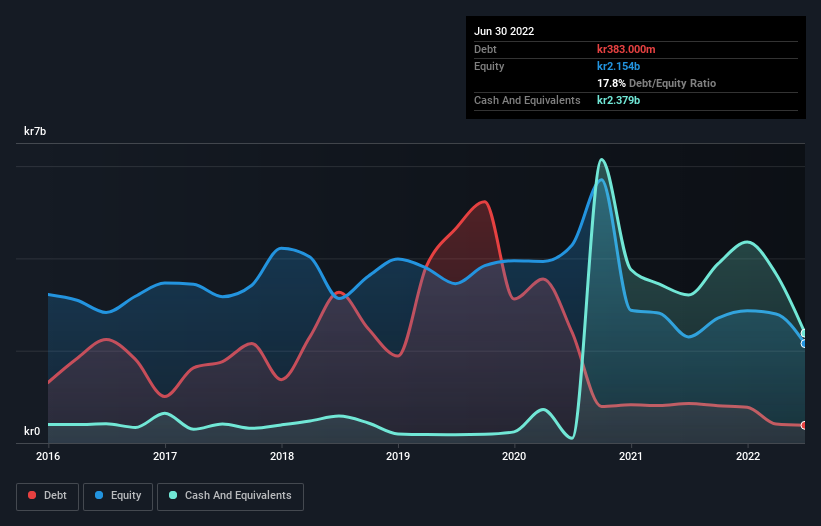
Legendary fund manager Li Lu (who Charlie Munger backed) once said, 'The biggest investment risk is not the volatility of prices, but whether you will suffer a permanent loss of capital.' When we think about how risky a company is, we always like to look at its use of debt, since debt overload can lead to ruin. We note that Veidekke ASA (OB:VEI) does have debt on its balance sheet. But the more important question is: how much risk is that debt creating?
When Is Debt Dangerous?
Generally speaking, debt only becomes a real problem when a company can't easily pay it off, either by raising capital or with its own cash flow. In the worst case scenario, a company can go bankrupt if it cannot pay its creditors. However, a more common (but still painful) scenario is that it has to raise new equity capital at a low price, thus permanently diluting shareholders. By replacing dilution, though, debt can be an extremely good tool for businesses that need capital to invest in growth at high rates of return. When we examine debt levels, we first consider both cash and debt levels, together.
Check out the opportunities and risks within the NO Construction industry.
What Is Veidekke's Debt?
You can click the graphic below for the historical numbers, but it shows that Veidekke had kr383.0m of debt in June 2022, down from kr855.0m, one year before. However, its balance sheet shows it holds kr2.38b in cash, so it actually has kr2.00b net cash.

How Healthy Is Veidekke's Balance Sheet?
We can see from the most recent balance sheet that Veidekke had liabilities of kr12.5b falling due within a year, and liabilities of kr2.38b due beyond that. Offsetting these obligations, it had cash of kr2.38b as well as receivables valued at kr7.43b due within 12 months. So its liabilities outweigh the sum of its cash and (near-term) receivables by kr5.03b.
While this might seem like a lot, it is not so bad since Veidekke has a market capitalization of kr11.6b, and so it could probably strengthen its balance sheet by raising capital if it needed to. However, it is still worthwhile taking a close look at its ability to pay off debt. While it does have liabilities worth noting, Veidekke also has more cash than debt, so we're pretty confident it can manage its debt safely.
But the other side of the story is that Veidekke saw its EBIT decline by 7.4% over the last year. If earnings continue to decline at that rate the company may have increasing difficulty managing its debt load. The balance sheet is clearly the area to focus on when you are analysing debt. But it is future earnings, more than anything, that will determine Veidekke's ability to maintain a healthy balance sheet going forward. So if you want to see what the professionals think, you might find this free report on analyst profit forecasts to be interesting.
Finally, while the tax-man may adore accounting profits, lenders only accept cold hard cash. Veidekke may have net cash on the balance sheet, but it is still interesting to look at how well the business converts its earnings before interest and tax (EBIT) to free cash flow, because that will influence both its need for, and its capacity to manage debt. Over the last three years, Veidekke actually produced more free cash flow than EBIT. That sort of strong cash conversion gets us as excited as the crowd when the beat drops at a Daft Punk concert.
Summing Up
Although Veidekke's balance sheet isn't particularly strong, due to the total liabilities, it is clearly positive to see that it has net cash of kr2.00b. The cherry on top was that in converted 124% of that EBIT to free cash flow, bringing in kr832m. So we are not troubled with Veidekke's debt use. There's no doubt that we learn most about debt from the balance sheet. But ultimately, every company can contain risks that exist outside of the balance sheet. These risks can be hard to spot. Every company has them, and we've spotted 1 warning sign for Veidekke you should know about.
When all is said and done, sometimes its easier to focus on companies that don't even need debt. Readers can access a list of growth stocks with zero net debt 100% free, right now.
New: Manage All Your Stock Portfolios in One Place
We've created the ultimate portfolio companion for stock investors, and it's free.
• Connect an unlimited number of Portfolios and see your total in one currency
• Be alerted to new Warning Signs or Risks via email or mobile
• Track the Fair Value of your stocks
Have feedback on this article? Concerned about the content? Get in touch with us directly. Alternatively, email editorial-team (at) simplywallst.com.
This article by Simply Wall St is general in nature. We provide commentary based on historical data and analyst forecasts only using an unbiased methodology and our articles are not intended to be financial advice. It does not constitute a recommendation to buy or sell any stock, and does not take account of your objectives, or your financial situation. We aim to bring you long-term focused analysis driven by fundamental data. Note that our analysis may not factor in the latest price-sensitive company announcements or qualitative material. Simply Wall St has no position in any stocks mentioned.
About OB:VEI
Veidekke
Operates as a construction and property development company in Norway, Sweden, and Denmark.
Excellent balance sheet and good value.
Similar Companies
Market Insights
Community Narratives


